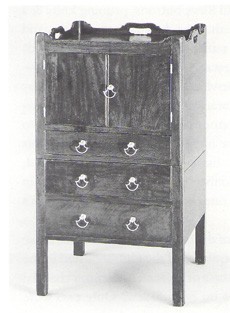

Parlor, Governor's Palace. (Photo, Colonial Williamsburg Foundation.) The design of the reproduction couch conforms to one that George Washington ordered from Philip Bell in London.

Study, Governor's Palace, showing prints "brass nailed" to the walls. (Photo, Colonial Williamsburg Foundation.)


Field bed with red check curtains, stable, Governor's Palace. (Photo, Colonial Williamsburg Foundation.)

Dining room, Governor's Palace. (Photo, Colonial Williamsburg Foundation.)

Side chair, England, 1760—1770. Mahogany with beech. H. 37 1/2", W: 22 1/2". (Colonial Williamsburg Foundation, acc. 1985-259.) According to tradition, this chair was purchased at the sale of Governor Dunmore's furnishings by a member of the Ambler family; however, identical chairs survive at Badminton, and they could be associated with Botetourt. It is conceivable that this chair was Botetourt's and that it was used by Dunmore after Botetourt died.

Ballroom, Governor's Palace, detail showing the wallpaper and border. (Photo, Colonial Williamsburg Foundation.)

Opposite view of the bedchamber in fig. 4 showing the bamboo chairs. (Photo, Colonial Williamsburg Foundation.)

Arm chair (left), England, 1770-1780. Beech. H. 36 5/8", W. 19 1/2". (Colonial Williamsburg Foundation, acc. 1936—344.) A somewhat more robust version of the bamboo chair than the Linnell examples referred to above, this chair originally was painted yellow-white with a glazed overcoat of varnish in imitation of bamboo. The chairs to the right are from a set of twelve reproductions made for the Palace.

Plate 54 from Thomas Chippendale's The Gentleman and Cabinet-Maker's Director (3d. ed., 1762). (Photo, Colonial Williamsburg Foundation.)

Nightstand, eastern Virginia, probably Williamsburg, 1765—1775. Mahogany with yellow pine. H. 32 3/4", W. 18 1/4". (Colonial Williamsburg Foundation, acc. 1985—40.) This nightstand is typical of the sophisticated, London-style furniture made by Williamsburg cabinetmakers during Botetourt's residence.

Plate 54 from Thomas Chippendale's The Gentleman and Cabinet-Maker's Director (1st. ed., 1754). (Photo, Colonial Williamsburg Foundation.)

Firescreen, probably Virginia, 1760-1770. Mahogany with oak and yellow pine. H. 42", W. 74". (Kenmore Association, on loan to Colonial Williamsburg; photo, Colonial Williamsburg Foundation.)
